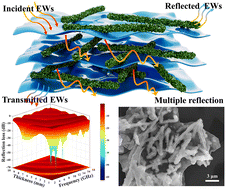Construction of Ni@polypyrrole nanochains/Ti3C2Tx ternary composites with excellent microwave absorption properties†
Abstract
Electromagnetic radiation has been a special form of environmental pollution that has attracted widespread attention in the past few decades. Combining the advantages of one-dimensional (1D) materials forming conductive networks and two-dimensional (2D) materials possessing multiple reflections is an excellent research method for the development of electromagnetic wave (EW) absorbing materials. Herein, Ni@polypyrrole nanochains/Ti3C2Tx (Ni@PPy NCs/Ti3C2Tx, NiPM) ternary composites have been successfully prepared through the combined utilization of the solvothermal method, hydrothermal method and vacuum-assisted filtration. The ternary composites consisting of 1D core-shell Ni@PPy NCs (NiP) and 2D Ti3C2Tx can effectively combine conductive loss, dielectric loss and magnetic loss, resulting in excellent impedance matching. The minimum reflection loss (RLmin) of the prepared ternary composites can be up to −62.61 dB at 6.82 GHz with a thickness of 2.71 mm while the effective absorption bandwidth (EAB) is 4.46 GHz at 1.38 mm. This work provides a general guideline for the development of a MXene and conducting polymer matrix design for EW absorbing materials.



 Please wait while we load your content...
Please wait while we load your content...